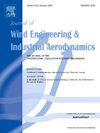利用物理信息神经网络重建骤降风场
IF 4.2
2区 工程技术
Q1 ENGINEERING, CIVIL
Journal of Wind Engineering and Industrial Aerodynamics
Pub Date : 2024-10-29
DOI:10.1016/j.jweia.2024.105935
引用次数: 0
摘要
降温飓风作为一种局部强风事件,对世界各地的工程结构造成了重大破坏。然而,由于这种强风在空间和时间上的随机性,现场测量往往难以在短时间内获得足够有效的风场信息。为了提高风场的分辨率,本研究提出了一种基于物理信息神经网络(PINN)的方法,以从有限的观测数据中重建降温过程。将纳维-斯托克斯(N-S)方程嵌入全连接神经网络,作为构建 PINN 的物理约束条件。然后,通过重建大涡模拟产生的数值下沉气流来验证 PINN 模型。PINN 重建的稀疏下沉风场在内插法和外推法预测中均表现良好。通过对训练数据和网络参数的影响进行参数分析,评估了 PINN 的最佳构造。最后,利用最优 PINN 结构重建了实验数据的风场,水平风速的相对误差为 5%。本文章由计算机程序翻译,如有差异,请以英文原文为准。
Reconstruction of downburst wind fields using physics-informed neural network
Downbursts, as a strong localized wind event, have caused significant damage to engineering structures throughout the world. However, given the spatial and temporal randomness of such strong winds, on-site measurements are often difficult to obtain a sufficient amount of valid wind field information in a short period of time. To refine the resolution of the wind field, this study proposes a physics-informed neural network network-based (PINN-based) approach to reconstruct the downburst from limited observed data. The Navier-Stokes (N-S) equations are embedded into the fully connected neural network as a physical constraint to construct the PINN. The PINN model is then validated by the reconstruction of numerical downburst generated by large eddy simulations. The reconstruction of the sparse downburst wind field by PINN performs well in both interpolation and extrapolation prediction. The optimal construction of the PINN has been evaluated through parameter analysis of the influence of training data and network parameters. Finally, the optimal PINN construction is used to reconstruct the wind field of the experimental data with a relative error of 5% for the horizontal wind velocity.
求助全文
通过发布文献求助,成功后即可免费获取论文全文。
去求助
来源期刊
CiteScore
8.90
自引率
22.90%
发文量
306
审稿时长
4.4 months
期刊介绍:
The objective of the journal is to provide a means for the publication and interchange of information, on an international basis, on all those aspects of wind engineering that are included in the activities of the International Association for Wind Engineering http://www.iawe.org/. These are: social and economic impact of wind effects; wind characteristics and structure, local wind environments, wind loads and structural response, diffusion, pollutant dispersion and matter transport, wind effects on building heat loss and ventilation, wind effects on transport systems, aerodynamic aspects of wind energy generation, and codification of wind effects.
Papers on these subjects describing full-scale measurements, wind-tunnel simulation studies, computational or theoretical methods are published, as well as papers dealing with the development of techniques and apparatus for wind engineering experiments.

 求助内容:
求助内容: 应助结果提醒方式:
应助结果提醒方式:


